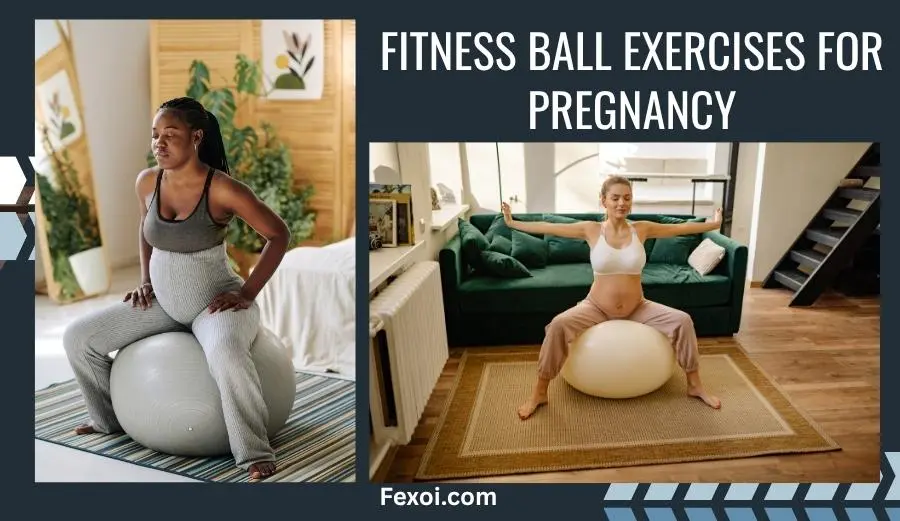Looking for safe and gentle workouts during pregnancy? Fitness ball exercises for pregnancy can support your body, relieve pain, and prep you for delivery.
Why Fitness Ball Exercises for pregnancy Are Ideal
Staying active during pregnancy offers numerous physical and emotional benefits but not all workouts are pregnancy-safe. That’s when a fitness ball—also called a birthing or exercise ball can help. These large, inflatable balls provide support, comfort, and versatility, making them ideal for expecting moms who want a gentle yet effective way to stay fit.
Benefits include:
- Improved posture and balance
- Strengthened pelvic floor and core muscles
- Reduced back, hip, and tailbone pain
- Enhanced flexibility and blood flow
- Better fetal positioning and birth preparation
No matter if you’re in your first trimester or close to your due date, pregnancy exercises with the ball can be adjusted to match your comfort.
Choosing the Right Ball for Pregnancy Workouts
What Size Exercise Ball Should You Use?
Choosing the correct size is key to ensuring safety and effectiveness. When you sit on the ball, make sure your knees are level with or just below your hips.
Here’s a quick sizing guide:
- Height under 5’4” → 55 cm ball
- Height between 5’4”–5’11” → 65 cm ball
- Height over 6’0” → 75 cm ball
Use a burst-resistant ball and make sure it’s inflated correctly.
Warm-Up Tips Before Pregnancy Ball Workouts
Before diving into your pregnancy exercise ball workouts, begin with a 5–10 minute warm-up. Marching in place, shoulder rolls, and gentle stretches help increase circulation and prepare your muscles.
Safety Guidelines
- After the first trimester, avoid lying flat on your back.
- Support yourself against a wall or sturdy surface when needed.
- Stop if you feel dizzy, short of breath, or experience any discomfort.
- Always consult with your OB-GYN or midwife before starting new exercises.
7 Best Fitness Ball Exercises for Pregnancy
These safe and effective movements target key areas that support pregnancy and prepare you for labor.
1. Pelvic Tilts on the Ball
- Sit on the ball with your feet flat on the floor.
- Gently tilt your pelvis forward and backward.
- This move helps strengthen your core and eases lower back pain.
2. Hip Circles
- Sit comfortably on the ball.
- Gently rotate your hips in a circle begin clockwise, then go counterclockwise.
- This boosts pelvic flexibility and improves blood flow.
3. Wall Squats with the Ball
- Stand with the ball placed between your lower back and a wall.
- Lower into a squat slowly, making sure your knees stay behind your toes.
- This exercise works your thighs and glutes.
4. Seated Marches
Sit on the ball and gently lift one foot at a time in a slow, controlled march. Great for balance and coordination.
5. Child’s Pose Stretch
Kneel in front of the ball, rest your arms on top, and slowly roll forward to relax. This relaxes the spine and stretches the back.
6. Arm Raises with Support
Sit on the ball and hold light dumbbells or water bottles. Raise your arms to the sides or front to build upper body strength safely.
7. Bouncing for Labor Prep
In the third trimester, gentle bouncing can encourage baby’s descent and improve positioning for labor. It also feels great for the lower back!

Pregnancy Conditions the Ball Can Help With
Pregnancy can bring on discomforts fortunately, many can be relieved with consistent use of a fitness ball.
1. Lower Back Pain
Sitting on the ball supports proper posture and spinal alignment, helping reduce strain on your back.
2. Round Ligament Pain
Gentle hip circles can ease the pulling sensation caused by stretching ligaments.
3. Sciatica and Hip Pain
Ball-supported movements relieve pressure on the sciatic nerve and hip joints.
4. Rib and Diaphragm Pressure
Stretching over the ball opens up space in the upper torso, making breathing easier.
Fitness Ball for Labor and Delivery
Fitness balls aren’t just for prenatal workouts—they’re helpful during labor too.
Encourages Baby’s Descent
Movements like bouncing and hip rocking help baby move into the pelvis.
Eases Contractions
Leaning forward on a ball during labor provides comfort and reduces back pain.
Opens the Pelvis
Sitting upright on the ball uses gravity to your advantage and may help shorten labor.
FAQs About Fitness Ball Pregnancy Exercises
Q: Are fitness balls safe for all trimesters?
Yes, when used properly. Modify exercises as your body changes and prioritize comfort and stability.
Q: Can I replace my office chair with a fitness ball during pregnancy?
Yes. It encourages active sitting and better posture, but don’t use it for long, uninterrupted hours.
Q: When should I start using a ball for pregnancy workouts?
You can begin as early as the first trimester, with your provider’s approval.
Final Thoughts
Fitness ball exercises for pregnancy are an accessible, low-impact way to stay active, relieve discomfort, and prepare your body for a smoother labor. Whether you’re bouncing to ease back pain, stretching for flexibility, or practicing positions for birth, incorporating a ball into your routine can offer tremendous physical and mental benefits.
Remember: consistency matters more than intensity. Even just 15–20 minutes a day of exercise ball pregnancy exercises can make a big difference.







